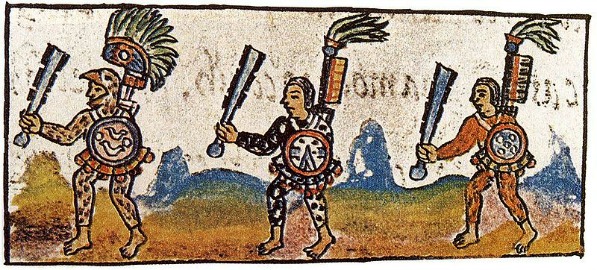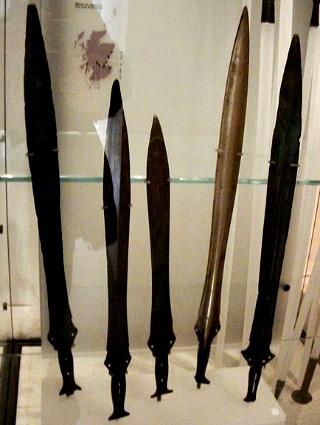The History of the Sword
What is a Sword?
A sword is made up of two main parts, the blade and the hilt. The hilt is the upper section of a sword and consists of a grip for holding the weapon, a
guard to protect the hands and a pommel that acts as a counterweight to the blade giving the sword its balance.
The pommel is usually a round knob that is positioned at the
top of the handle and can be used to strike an opponent when required. Sword blades come in various shapes and sizes and can be straight or curved and single-edged, i.e., sharp on just one side or double-edged meaning both sides of the blade are sharp.
Talk the Talk
The English word sword is translated into Dutch as zwaard and in German it is schwert, and it is likely that they all derive from
the same Anglo-Saxon word, sweord. In Italy, the sword is known as a spada and in Spain it is espada, and these translations stem from the ancient Latin
word spatha.
The sword is one of the most common weapons known to man and first appeared in the Bronze Age around the seventeenth century BCE in the Black Sea region and the Aegean.
Further Reading:

From that time there was some development as the weapon spread but the sword saw its most important advances in around one thousand BCE, when sword smiths began using iron instead of bronze in their construction.
Bronze Age Swords
In the Bronze Age, swords could be made in one of two ways. Some would be cast in a mould however the more effective method was to hammer the basic shape directly from a lump of bronze and then finish the job by grinding the sword on a stone.
The second method was better as it made the metal harder whereas cast bronze tended to be more brittle, meaning it was more likely to break in battle.
One of the most common sword types of this era had a leaf-shaped blade that widened in the centre and ended in a point. This type of blade was easier to make with the technology available at the time and may have originated as a fusion of a spearhead and a dagger. The leaf-shaped blade could be found across Europe and in Egypt and was usually around 22 inches long (56 CM), though some have been found as long as 32 inches (81 CM).
Classification of Swords
Many different types of swords have been used throughout history, some of the more common are:
- The two-edged straight sword
- The one-edged sword straight or curved
- The one-edged spud ended sword
- The curved sword with expanding blade (scimitar)
- The curved pointed sword edged on the inner (concave) edge
- The Egyptian falchion
- Miscellaneous types, for example, the flamberge or the executioner’s sword
We can loosely classify types of swords to geographical regions, as the swords in Asia, Europe and Africa tend to be relatively unique to those areas
(though there is plenty of overlap and some swords from Asia and sub-Sahara Africa originated in Egypt). Swords can also be classified as either two-handed swords such as the medieval European broadsword or swords that were designed to be used with one hand only such as the rapier. In Europe, swords tended to have straight blades whereas in Asia and the Middle East, the blades tend to be curved.
In Australia and the Americas, metal swords were not developed though in South and Central America, native cultures used a wooden sword called a macuahuitl (pictured below) which the Mayan, Mixtec, Toltec and Aztecs studded with shards of obsidian glass to create a cutting edge that could be sharper than a razor blade.
Throughout the history of swords, their design has varied and evolved in many ways and many different and diverse places and continues to do so to this day. Warriors have often had a fascination with their sword beyond just seeing it as a means to kill an opponent or as an instrument of self-defence. In many cultures, the ruling elites such as the Medieval Knights of Europe and the Japanese Samurai formed a special bond with their sword, with some even believing that the weapon held the soul of the warrior who wielded it.
Written by Andrew Griffiths – Last updated 09/10/2023. If you like
what you see, consider following the History of Fighting on social media.
Further Reading:
History of Swords. [Internet]. 2018. Knights Edge Ltd. Available From:
https://www.knightsedge.com/s-123-history-of-swords.aspx [Accessed Oct 27, 2018].
J. W. Latham & R. W. Latham. [Internet]. 2018. The Evolution of Swords. Pooley Swords. Available From: http://pooleysword.com/en/Evolution_of_Swords [Accessed Oct 27, 2018].
William J.
McPeak. [Internet]. 2018. The History of the Sword. Warfare History Network. Available from: http://warfarehistorynetwork.com/daily/military-history/the-history-of-the-sword [Accessed Oct 27, 2018].

More Sword History
The Japanese Samurai Sword
The samurai sword, it is said, was believed to contain the soul of the warrior who owned it. While this is probably an over romanticised view, it is true to say that there was a spiritual connection not only for the wielder of the katana, but also for the sword smith and his creation.
The samurai sword, it is said, was believed to contain the soul of the warrior who owned it. While this is probably an over romanticised view, it is true to say that there was a spiritual connection not only for the wielder of the katana, but also for the sword smith and his creation.
The images on this site are believed to be in the public domain, however, if any mistakes have been made and your copyright or intellectual rights have been breeched, please contact andrew@articlesonhistory.com.


 thumb.jpg?timestamp=1582883344133)